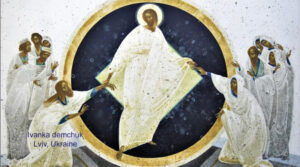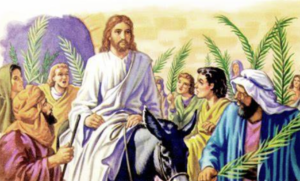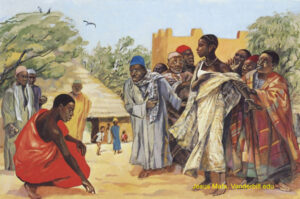“That very day, the first day of the week, two of Jesus’ disciples were going to . . . Emmaus, and they were conversing about all the things that had occurred and . . . Jesus himself drew near and walked with them, but their eyes were prevented from recognizing him. . . .
They said to him, ‘. . . Some women from our group have astounded us: they were at the tomb. . . and did not find his body; they came back and reported that they had indeed seen a vision of angels who announced that he was alive. Then some of those with us went to the tomb and found things just as the women had described, but him they did not see.’
And he said to them, ‘Oh, how foolish you are! How slow of heart to believe all that the prophets spoke!’” Luke 24:13-16, 22-25
+++++
This is the second time in two weeks, Easter Sunday to now, that we are hearing this Gospel story, first from John and now from Luke, so it must have some messages that the Church considers to be important enough for us to hear it again in so short a time.1 Here I focus on two of the six events2 in the passage, the women at the empty tomb and the two disciples walking with Jesus on the road to Emmaus.
Both events are accounts of disciples hearing news about something they never expected , the Resurrection of Jesus, their beloved teacher and friend. Their reactions to that news are quite different and, instead of focusing on Jesus in the story, let’s focus on the disciples, how they prepared for hearing strange news about Jesus and how we mimic their preparation for hearing about the Resurrection which is seen even today as strange news and by some, as fake news.
THE DISCIPLES’ AND OUR REACTIONS TO NEWS OF THE RESURRECTION
The women did not see or talk to Jesus in Luke’s version of the story3; even so, they appear to believe Jesus has risen, I suspect, based upon His body not being there and, perhaps because, as the Emmaus disciples report, the women saw “a vision of angels who announced that He is alive.” The women did not “see” or “talk” with Jesus and yet they seemed to believe the “strange” things they were told about Him. What could have made it possible for them to believe the report of such an unusual event?
Might it have been that their time spent with Jesus during the months and years before arriving at the tomb were spent in a deeper than superficial presence to Him? And might that presence throughout the time that he was their teacher and friend have led them to a subconscious deeper sense of Who He was and an exposure to the power that resided within Him? (And what about our presence to Jesus during the months and years of our lives and at Mass, too? Is there a subconscious deeper sense of Who He is? Could there be? Should there be? Or do I have just a superficial sense of Who Jesus is?)
Something like believing that a crucified person with a sword-pieced heart could be alive, can happen only if either one lacks the capacity to understand that crucifixion destroys life or one “knows” something that, in one’s mind, makes it possible for this person still to be alive. So, if this was a crucifixion like others performed at that time and place and all the other crucified died, why would the women think it possible that what the angel said was true and Jesus was raised from death? To me, it would have had to be what they discovered about Him as they walked, talked, listened and ate with Him during the months and years before they arrived at the empty tomb.
Some day, we, too, will arrive at a tomb of our own, one that contains our body but not our soul. And, because Jesus is Risen and has told us that he did not leave us orphans, that the Holy Spirit is with us, we should have – could have, if we let ourselves believe – walked, talked, listened and eaten with Jesus during the months and years before we arrive at our own empty tombs. The most important of those times are when we are at Mass, remembering His actions and His presence in a very real and special way.
Are we like the women in this Gospel story? Or are we like the disciples on the Road to Emmaus who are still struggling to let our minds and hearts see Him and believe that He has risen?
Ponder this: How we relate to Jesus when we are not assembled as a worshiping community affects what we see and hear in the midst of the worshiping community.
MASCULINE VS. FEMININE
I have heard people say about this story that the women found it easier to believe in the Resurrected Jesus than the men (although we do not know for sure that the road to Emmaus disciples were both men) because of “female” characteristics such as an ability to nurture and to see the heart of the person. Perhaps. But there is no masculine or feminine in God and I often wonder why God made us the way God did, “male and female He created us.” Could it be for us to experience something of the Trinity in our relationships with each other now while our hearts are still pumping and we are still breathing? Could it be that our own and each other’s made-in-the-image-of-God-ness rises to a new level as we recognize the made-in-the-image-of-God-ness in the different-from-ourselves “others”, and especially in the profoundly God-seeking individuals we meet in life? Aloneness and sameness preserve oneself; Trinitarian tendencies generate communal joy and peace. Have we come to know and honor the made-in-the-likeness-of-God-ness in others and, like the women at the empty tomb, come to a rejoicing belief that the Risen Jesus is still in our midst?
OH, HOW FOOLISH YOU ARE
In Luke’s Road to Emmaus account the disciples end their story with “Then some of those with us went to the tomb and found things just as the women had described, but him they did not see.’” to which Jesus replies, “‘Oh, how foolish you are! How slow of heart to believe all that the prophets spoke!’” Luke 24:13-16, 24-25
Would Jesus say this to us, too? “Oh, how foolish you are! How slow of heart to believe.” I am reminded of Bishop Robert Barron’s story of author Flannery O’Connor.
“It was commonplace among the intellectual of her time that Catholic talk of Incarnation, virgin birth, walking on water and Resurrection was naïve, a holdover from when people were innocent of science and hard thinking. But these miracles, she held, were not so much violations of the laws of nature, but rather the disclosure of the way things really are. She writes, ‘For me it is the virgin birth, the Incarnation, the resurrection which are the true laws of the flesh and the physical. Death, decay, destruction are the suspension of these laws.’” (Flannery O’Connor, The Habit of Being) Robert Barron, Catholicism Pivotal Players: Flannery O’Connor
Sister Loretta Fernandez RSM
___________
1. When I prepare for the celebration of Mass by meditating on the readings ahead of time, which is what the homilist does, too, I find it helpful to use the readings and the Bible that are on the U.S. Catholic Conference of Bishops website (usccb.org). On the homepage is a calendar that links to the readings of the day and each reading of the day has a link to that book and verse in the online approved translation of the Bible.
The Sunday Reading passage is Luke 24: 13-35 and, if you look at the Book of Luke in the Bishops’ website Bible, an approved translation, you see this footnote:
* [24:13–35] This episode focuses on the interpretation of scripture by the risen Jesus and the recognition of him in the breaking of the bread. The references to the quotations of scripture and explanation of it (Lk 24:25–27), the kerygmatic proclamation (Lk 24:34), and the liturgical gesture (Lk 24:30) suggest that the episode is primarily catechetical and liturgical rather than apologetic.
The Bible text contains asterisks and lettered footnotes that help in the exploration of the meaning of the text. And since this is an online Bible, you can search the web for the meaning of any words. For instance, in the above footnote:
kerygmatic – related to proclamation of the Gospel; catechetical – related to teaching us something; liturgical – related to public worship; apologetic – in defense of a doctrine.
2. The disciples on the road to Emmaus
The women at the tomb
Their reporting what they saw and happened there
The disciples checking what the women report
The two disciples’ dining with Jesus
The two disciples relating their encounter with the Risen Jesus to the disciples gathered in Jerusalem.
3. See the usccb.org footnote m for other versions.




